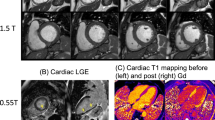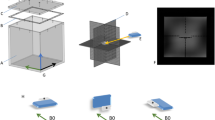Abstract
Objectives
Radio frequency (RF) pulses in magnetic resonance imaging (MRI) can interact with implanted devices and cause tissue damage. However, there are new devices that can safely perform measurements with liberal MRI conditions such as an RF transmission field B1+rms ≤ 2.0 μT. We investigated whether MRI in this case is limited for these technical reasons.
Methods
We selected typical MRI protocols of six body regions (brain, cervical spine, lumbar spine, knee, liver, heart) using two typical 1.5T MRI scanners. Overall, we adapted 62 sequences to B1+rms conditions and evaluated their diagnostic quality. For this, we measured signal-to-noise-ratio (SNR), contrast-to-noise-ratio (CNR), and geometric deviation (GD) as quality parameters, using phantom studies. For questionnaire studies, we selected pairs of original and adapted sequences in healthy volunteers. Blinded radiologists rated the images as single sequence rating and in direct comparison.
Results
Roughly one-third of the checked sequences were below the B1+rms limit. Here, 56 of the 62 adapted sequences showed at least the same image quality in single ratings. A reduction in SNR and/or CNR was found with 31 sequences and only one sequence with considerably increased GD. Especially, sequences with original high B1+rms values, PD sequences, and sequences of the Siemens knee and heart protocol were difficult to adapt, whereas most TSE and IR sequences had no clinical limitations.
Conclusion
By limiting the transmission field to B1+rms ≤ 2.0 μT, clinically relevant MR sequences can be adapted with nearly no reduction in image quality. Despite limiting the transmission field, high-quality MR imaging is possible. We could derive strategies for adaptation.
Key Points
• Despite limiting the transmission field, high-quality MRI is possible.
• We could derive strategies for adapting the sequences to B 1+rms ≤ 2.0 μT.
• This enables high-quality MRI of different body regions for patients with AD.



Similar content being viewed by others
Abbreviations
- AD:
-
Active device
- B1:
-
B1 field strange
- Blade:
-
Periodically rotated overlapping parallel lines with enhanced reconstruction
- CNR:
-
Contrast-to-noise-ratio
- GD:
-
Geometric deviation
- MRI:
-
Magnetic resonance imaging
- PD:
-
Proton density weighted image
- RF:
-
Radio frequency
- SAR:
-
Specific absorption rate
- SE:
-
Spin echo
- SNR:
-
Signal-to-noise-ratio
- Stir:
-
Short T1 inversion recovery
- TSE:
-
Turbo spin echo
References
OECD Data (2018) Magnetic resonance imaging (MRI) exams. OECD Data, Paris. Available via https://data.oecd.org/healthcare/magnetic-resonance-imaging-mri-exams.htm. Accessed 22 Aug 2019
Wodarg F, Herzog J, Reese R et al (2012) Stimulation site within the MRI-defined STN predicts postoperative motor outcome. Mov Disord 27:874–879
Cabot E, Lloyd T, Christ A et al (2013) Evaluation of the RF heating of a generic deep brain stimulator exposed in 1.5 T magnetic resonance scanners. Bioelectromagnetics 34:104–113
Cross NM, Hoff MN, Kanal KM (2018) Avoiding MRI-related accidents: a practical approach to implementing MR safety. J Am Coll Radiol 15:1738–1744
Shellock FG (2002) Magnetic resonance safety update 2002: implants and devices. J Magn Reson Imaging 16:485–496
Franceschi AM, Wiggins GC, Mogilner AY, Shepherd T, Chung S, Lui YW (2016) Optimized, minimal specific absorption rate MRI for high-resolution imaging in patients with implanted deep brain stimulation electrodes. AJNR Am J Neuroradiol 37:1996–2000
Medtronic plc MRT-Scans bei Medtronic-DBS-Systemen: Überblick für Radiologie. Medtronic plc, Dublin. Available via http://www.medtronic.com/content/dam/medtronic-com/de-de/hcp/documents/neurostimulationssysteme-dbs/mrt-leitlinien/mrt-dbs-uebersicht.pdf. Accessed 22 Aug 2019
President & Strategic Intelligence (2017) Global Active Implantable Medical Devices Market: Size, Share, Development, Growth and Demand Forecast to 2023. President & Strategic Intelligence, Noida. Available via https://www.psmarketresearch.com/market-analysis/active-implantable-medical-devices-market. Accessed 22 Aug 2019
Sarkar SN, Papavassiliou E, Rojas R et al (2014) Low-power inversion recovery MRI preserves brain tissue contrast for patients with Parkinson disease with deep brain stimulators. AJNR Am J Neuroradiol 35:1325–1329
Sarkar SN, Papavassiliou E, Hackney DB et al (2014) Three-dimensional brain MRI for DBS patients within ultra-low radiofrequency power limits. Mov Disord 29:546–549
Reitz G (2006) Vergleich der MRT des Kiefergelenks zwischen 1,5 T und 3,0 T unter Verwendung von Oberflächenspulen. Freie Universität Berlin. https://doi.org/10.17169/refubium-9435
Alai-Omid M (2010) Untersuchungen des Auges mit einer Oberflächenspule in einem 3,0-Tesla-MRT. Freie Universität Berlin. https://doi.org/10.17169/refubium-11883
Sarkar SN, Alsop DC, Madhuranthakam AJ et al (2011) Brain MR imaging at ultra-low radiofrequency power. Radiology 259:550–557
Silva VMF, Ramos IM, Marques M (2018) Magnetic resonance safety: are there new paradigms? ECR 2018 C-2090 https://doi.org/10.1594/ecr2018/C-2090
Hamilton J, Franson D, Seiberlich N (2017) Recent advances in parallel imaging for MRI. Prog Nucl Magn Reson Spectrosc 101:71–95
Zrinzo L, Yoshida F, Hariz MI et al (2011) Clinical safety of brain magnetic resonance imaging with implanted deep brain stimulation hardware: large case series and review of the literature. World Neurosurg 76:164–172
Larson PS, Richardson RM, Starr PA, Martin AJ (2008) Magnetic resonance imaging of implanted deep brain stimulators: experience in a large series. Stereotact Funct Neurosurg 86:92–100
Funding
This study has received funding from Medtronic.plc.
Author information
Authors and Affiliations
Corresponding author
Ethics declarations
Guarantor
The scientific guarantor of this publication is Prof. Dr. Med. Olav Jansen.
Conflict of interest
The authors of this manuscript declare no relationships with any companies whose products or services may be related to the subject matter of the article.
Statistics and biometry
No complex statistical methods were necessary for this paper.
Informed consent
Written informed consent was obtained from all subjects (patients) in this study.
Ethical approval
Institutional Review Board approval was obtained.
Methodology
• Prospective
• Randomized controlled trial
• Performed at one institution
Additional information
Publisher’s note
Springer Nature remains neutral with regard to jurisdictional claims in published maps and institutional affiliations.
Electronic supplementary material
ESM 1
(DOCX 85 kb)
Rights and permissions
About this article
Cite this article
Lunden, L., Wolff, S., Peters, S. et al. MRI in patients with implanted active devices: how to combine safety and image quality using a limited transmission field?. Eur Radiol 30, 2571–2582 (2020). https://doi.org/10.1007/s00330-019-06599-6
Received:
Revised:
Accepted:
Published:
Issue Date:
DOI: https://doi.org/10.1007/s00330-019-06599-6




